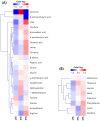Changes in Nutrient Components and Digestive Enzymatic Inhibition Activities in Soy Leaves by Ethephon Treatment
- PMID: 37896103
- PMCID: PMC10609866
- DOI: 10.3390/plants12203640
Changes in Nutrient Components and Digestive Enzymatic Inhibition Activities in Soy Leaves by Ethephon Treatment
Abstract
In this study, the high isoflavone-enriched soy leaves (IESLs) were manufactured by treating with the chemical inducer ethephon, a plant growth regulator, to confirm changes in the properties of soy leaves (SLs), which are underutilized. Ethephon treatment concentrations consisted of 0 (SL1), 150 (SL2), and 300 (SL3) μg/mL. The composition analysis and physiological activity were conducted according to the ethephon treatment concentration of SLs. There was no significant difference in the proximate composition and fatty acids, except for an increase with increasing ethephon treatment concentrations. Depending on the ethephon treatment concentration, free amino acids increased to 1413.0, 1569.8, and 2100.4 mg/100 g, and water-soluble vitamins increased to 246.7, 244.7, and 501.6 mg/100 g. In particular, the functional substance isoflavone increased significantly to 1430.11, 7806.42, and 14,968.00 μg/g. Through this study, it was confirmed that the nutritional components and isoflavones of SLs increased according to the ethephon treatment concentration, a chemical inducer treatment agent. This can be used as a high-value-added biosubstance for raw materials for functional foods, cosmetics, and for natural drugs.
Keywords: digestive enzymatic inhibition activity; ethephon; isoflavone; soybean leaf; water-soluble vitamin.
Conflict of interest statement
The authors declare no conflict of interest.
Figures








References
-
- Hsiao Y.H., Ho C.T., Pan M.H. Bioavailability and health benefits of major isoflavone aglycones and their metabolites. J. Funct. Foods. 2020;74:104164. doi: 10.1016/j.jff.2020.104164. - DOI
-
- Kim U.H., Yoon J.H., Li H., Kang J.H., Ji H.S., Park K.H., Shin D.H., Park H.Y., Jeong T.S. Pterocarpan-enriched soy leaf extract ameliorates insulin sensitivity and pancreatic β-cell proliferation in type 2 diabetic mice. Molecules. 2014;19:18493–18510. doi: 10.3390/molecules191118493. - DOI - PMC - PubMed
-
- Li H., Kang J.H., Han J.M., Cho M.H., Chung Y.J., Park K.H., Shin D.H., Park H.Y., Choi M.S., Jeong T.S. Anti-obesity effects of soy leaf via regulation of adipogenic transcription factors and fat oxidation in diet-induced obese mice and 3T3-L1 adipocytes. J. Med. Food. 2015;18:899–908. doi: 10.1089/jmf.2014.3388. - DOI - PubMed
Grants and funding
- RS-2023-00245096/the Basic Science Research Program through the National Research Foundation (NRF) funded by the Ministry of Education
- 821037031HD020/the Korea Institute of Planning and Evaluation for Technology in Food, Agriculture and Forestry (IPET), through the Technology Commercialization Support Program, funded by the Ministry of Agriculture, Food and Rural Affairs (MAFRA)
LinkOut - more resources
Full Text Sources

